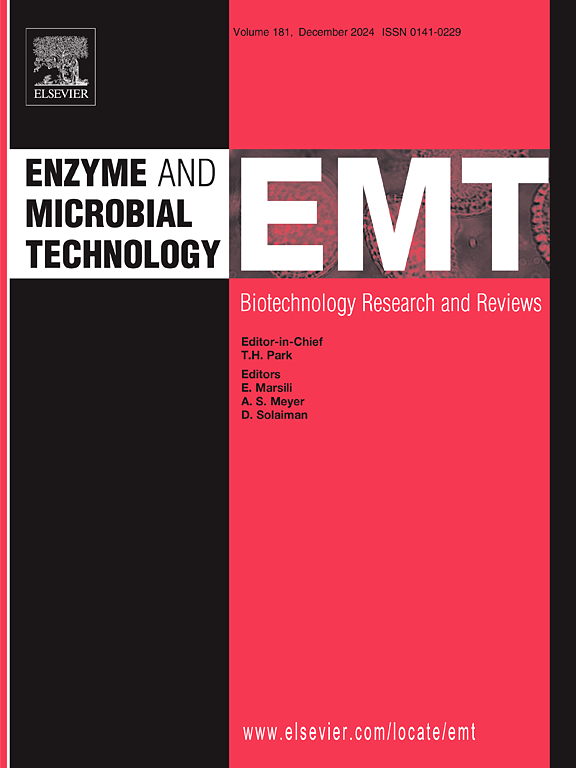The synthesis of cinnamyl acetate and deacetyl-7-aminocephalosporanic acid by a GDSL-type esterase and its substrate specificity analysis
IF 3.4
3区 生物学
Q2 BIOTECHNOLOGY & APPLIED MICROBIOLOGY
引用次数: 0
Abstract
GDSL-type esterases are promising biocatalysts for the food and pharmaceutical industries. Here, a GDSL-type esterase from Aspergillus niger CCTCC No. M2012538 (INANE1) was expressed and purified in Pichia pastoris GS115, and its catalytic performances were evaluated, including the synthesis of cinnamyl acetate and deacetyl-7-aminocephalosporanic acid (D-7-ACA). In addition, molecular docking and molecular dynamics simulations analyzed INANE1's substrate specificity. The substrate specificity profile indicated the recombinant esterase (rINANE1) was an acetylesterase with high specificity for p-nitrophenyl acetate (p-NPA). The rINANE1 exhibited maximum activity at pH 8.0 and 35 °C, where Km and Vmax were calculated as 0.13±0.03 mM and 22.56 ± 0.32 μmoL/min/mg, respectively. The yield of cinnamyl acetate of about 85 % was achieved in 24 h. The conversion rate of 7-aminocephalosporanic acid (7-ACA) could reach 92.71 ± 1.78 % at 25 °C and 2.5 h. Moreover, the INANE1 structure model, molecular docking, and molecular dynamics simulation demonstrated that the pocket of the catalytic triad Ser34, Asn267, and His270 could only accommodate p-NPA. INANE1 may be the first fungi esterase with cinnamyl acetate synthetic activity and 7-ACA hydrolysis activity. Therefore, INANE1 would be a promising enzyme with industrial values.
一种 GDSL 型酯酶合成乙酸肉桂酯和脱乙酰基-7-氨基头孢烷酸及其底物特异性分析。
GDSL 型酯酶是一种在食品和制药行业很有前景的生物催化剂。本文在 Pichia pastoris GS115 中表达并纯化了黑曲霉 CCTCC 编号 M2012538 的 GDSL 型酯酶(INANE1),并对其催化性能进行了评估,包括乙酸肉桂酯和脱乙酰基-7-氨基头孢烷酸(D-7-ACA)的合成。此外,分子对接和分子动力学模拟分析了 INANE1 的底物特异性。底物特异性曲线表明,重组酯酶(rINANE1)是一种乙酰酯酶,对对硝基苯乙酸酯(p-NPA)具有高度特异性。rINANE1 在 pH 值为 8.0、温度为 35 ℃ 时表现出最大活性,其 Km 和 Vmax 分别为 0.13±0.03 mM 和 22.56 ± 0.32 μmoL/min/mg 。在 24 小时内,乙酸肉桂酯的收率达到约 85%。在 25 °C、2.5 h 的条件下,7-氨基头孢烷酸(7-ACA)的转化率可达 92.71 ± 1.78 %。此外,INANE1结构模型、分子对接和分子动力学模拟表明,催化三元组Ser34、Asn267和His270的口袋只能容纳对-NPA。INANE1 可能是第一个具有乙酸肉桂酯合成活性和 7-ACA 水解活性的真菌酯酶。因此,INANE1 将是一种具有工业价值的酶。
本文章由计算机程序翻译,如有差异,请以英文原文为准。
求助全文
约1分钟内获得全文
求助全文
来源期刊

Enzyme and Microbial Technology
生物-生物工程与应用微生物
CiteScore
7.60
自引率
5.90%
发文量
142
审稿时长
38 days
期刊介绍:
Enzyme and Microbial Technology is an international, peer-reviewed journal publishing original research and reviews, of biotechnological significance and novelty, on basic and applied aspects of the science and technology of processes involving the use of enzymes, micro-organisms, animal cells and plant cells.
We especially encourage submissions on:
Biocatalysis and the use of Directed Evolution in Synthetic Biology and Biotechnology
Biotechnological Production of New Bioactive Molecules, Biomaterials, Biopharmaceuticals, and Biofuels
New Imaging Techniques and Biosensors, especially as applicable to Healthcare and Systems Biology
New Biotechnological Approaches in Genomics, Proteomics and Metabolomics
Metabolic Engineering, Biomolecular Engineering and Nanobiotechnology
Manuscripts which report isolation, purification, immobilization or utilization of organisms or enzymes which are already well-described in the literature are not suitable for publication in EMT, unless their primary purpose is to report significant new findings or approaches which are of broad biotechnological importance. Similarly, manuscripts which report optimization studies on well-established processes are inappropriate. EMT does not accept papers dealing with mathematical modeling unless they report significant, new experimental data.
 求助内容:
求助内容: 应助结果提醒方式:
应助结果提醒方式:


